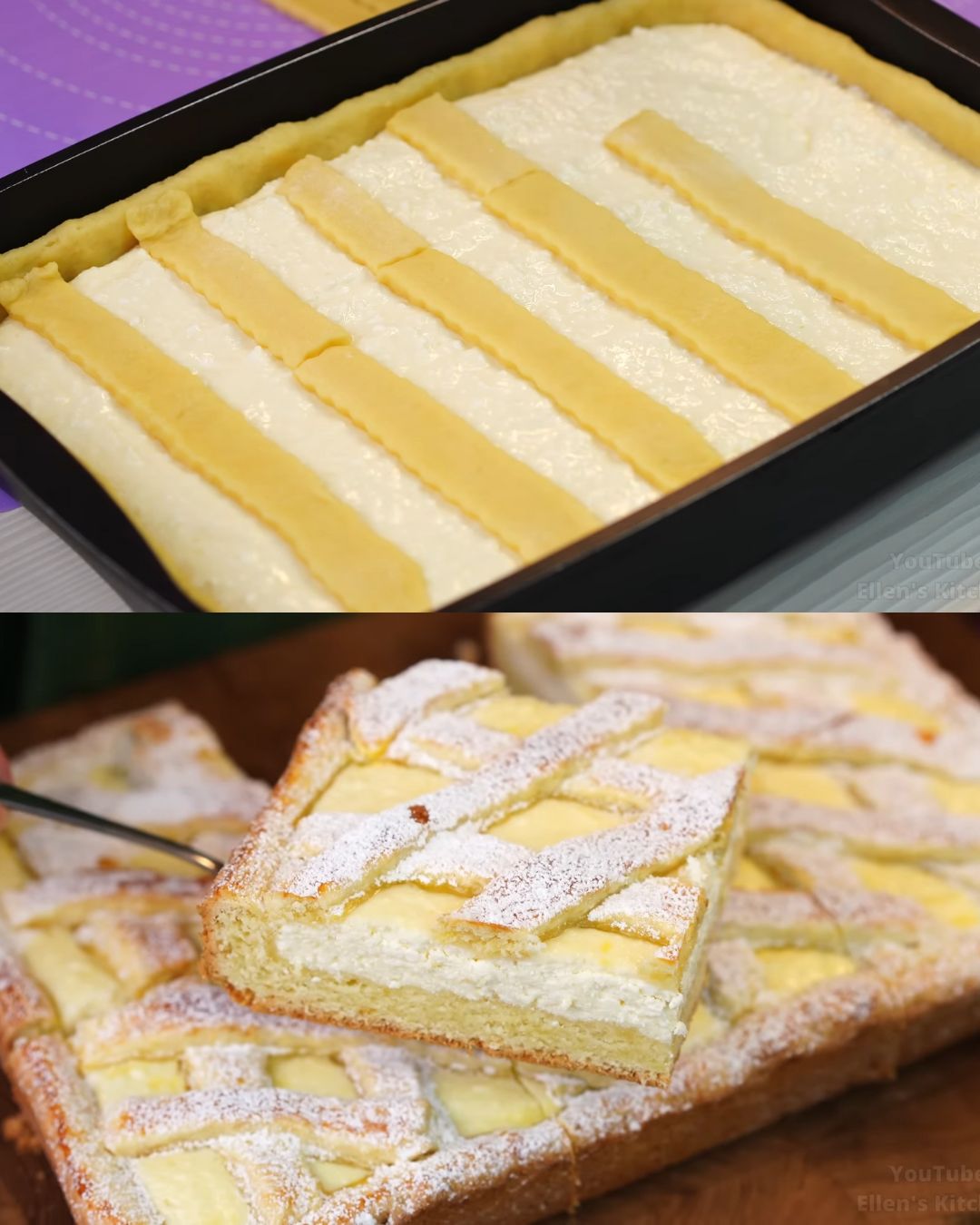If you’ve been looking for the ultimate balance between soft, buttery pastry and creamy, rich filling, you’ve just found it. These Classic Cottage Cheese Layer Bars are a timeless dessert that brings together the melt-in-your-mouth tenderness of homemade shortcrust with the delicate sweetness of a creamy cheese layer. Every bite is a comforting blend of textures: the crumbly base, the luscious cottage cheese center, and the golden, slightly crisp top. This is the kind of recipe that instantly transports you to a cozy kitchen filled with the scent of baked goods and the gentle hum of conversation. Whether you’re making it for a family gathering, a holiday table, or just to treat yourself on a quiet afternoon, this dessert delivers on taste, nostalgia, and presentation.
Unlike heavy cheesecakes, this recipe is lighter yet still indulgent. The pastry layers give it a structural beauty that looks impressive when sliced, but the preparation is straightforward enough for bakers of all levels. It’s a dessert that feels luxurious without being overly fussy — just the right amount of effort for a big reward.
Full Recipe
Ingredients
-
500 g flour
-
1 tbsp baking powder
-
Pinch of salt
-
100 g powdered sugar
-
200 g butter
-
2 eggs
-
100 g sour cream
-
2 eggs + 1 egg white (for filling)
-
1 tsp vanilla sugar
-
100 g sugar
-
500 g cottage cheese
-
30 g corn starch
-
1 egg yolk + 1 tsp milk (for brushing)
-
Extra powdered sugar for dusting
Cooking Directions
-
Prepare the Pastry Dough: In a large mixing bowl, combine flour, baking powder, a pinch of salt, and powdered sugar. Whisk together to evenly distribute the dry ingredients.
-
Cut in the butter using a pastry cutter, fork, or your fingertips until the mixture resembles coarse crumbs.
-
Add 2 eggs and sour cream to the bowl. Mix until a dough forms, being careful not to overwork it to keep the pastry tender.
-
Divide the dough into two equal portions. Wrap each in plastic wrap and refrigerate for 10–15 minutes to firm up.
-
Prepare the Filling: In another large bowl, beat 2 eggs and 1 egg white with vanilla sugar and granulated sugar until light and slightly fluffy, about 3–4 minutes.
-
Add cottage cheese and corn starch to the egg mixture. Blend until smooth and creamy.
-
Assemble the Layers: Preheat your oven to 180°C (356°F). Lightly grease a 30 × 20 cm baking dish or line it with parchment paper.
-
Roll out one portion of the chilled dough to fit the base of your prepared dish. Lay it evenly in the bottom.
-
Spread the cottage cheese filling evenly over the pastry base.
-
Roll out the second portion of dough and carefully place it over the filling, sealing the edges gently.
-
Brush the top layer with the beaten egg yolk mixed with milk to create a beautiful golden crust during baking.
-
Bake in the preheated oven for 40–45 minutes, or until the top is golden and set.
-
Remove from oven and allow to cool in the pan for at least 20 minutes.
-
Dust generously with powdered sugar before slicing into bars. Serve warm or at room temperature.
Nutrients (per serving, based on 12 servings)
-
Calories: ~310 kcal
-
Protein: 8 g
-
Fat: 15 g
-
Carbohydrates: 36 g
-
Fiber: 1 g
-
Sugars: 16 g
-
Sodium: 130 mg
Why You’ll Love This Recipe
You’ll love this recipe because it’s the perfect cross between comfort food and an elegant dessert. It doesn’t demand complicated skills or exotic ingredients — just pantry staples and some dairy magic. The layers are not just visually appealing; they create a delightful contrast in texture and flavor. The buttery shortcrust offers a crumbly bite, while the filling stays creamy and mildly tangy thanks to the cottage cheese. It’s also incredibly versatile — equally at home on a festive dessert table as it is with a casual cup of tea on a Sunday afternoon. Plus, it’s make-ahead friendly, which means less stress when entertaining.
The Origins and Inspiration Behind the Dish
Layered cottage cheese pastries have deep roots in Central and Eastern European baking traditions. Variations of this dessert are found in Hungarian, Polish, Ukrainian, and Russian kitchens, often passed down through generations. The inspiration for this recipe comes from the humble farmer’s kitchen, where dairy products were abundant and nothing went to waste. The combination of rich butter, fresh eggs, and tangy cottage cheese created desserts that were hearty enough to satisfy after a long day but special enough to be served on holidays. Over time, bakers refined the recipe, introducing baking powder for a lighter texture and incorporating powdered sugar for a more delicate sweetness. This particular version keeps the rustic charm while benefiting from modern baking techniques for consistent, delicious results every time.
Ingredient Spotlight
The star of this dessert is cottage cheese, which brings a unique texture and flavor that’s creamier than ricotta but lighter than cream cheese. When blended with sugar, eggs, and starch, it transforms into a silky filling that holds its shape while staying moist. Butter is the unsung hero here, giving the pastry layers their tender crumb and rich taste. Corn starch in the filling helps thicken it without adding heaviness, ensuring clean slices when you serve. Finally, a simple egg yolk and milk glaze is the little touch that makes the top irresistibly golden and slightly crisp.
Storage and Reheating Tips
These bars store beautifully, making them ideal for advance preparation. Once cooled completely, cover the pan tightly with plastic wrap or aluminum foil, or transfer the bars to an airtight container. Store in the refrigerator for up to 4–5 days. For longer storage, wrap individual slices in plastic wrap and freeze for up to 2 months. To reheat, thaw frozen bars in the fridge overnight, then warm them in a 150°C (300°F) oven for 8–10 minutes, or microwave briefly on low power to avoid drying them out.
Common Variations to Try
This recipe is wonderfully adaptable. You can add lemon zest to the filling for a bright, citrusy note, or swirl in a few tablespoons of fruit preserves for a berry-flavored twist. Dried fruits like raisins or chopped apricots can be folded into the filling for added sweetness and texture. If you prefer a richer dessert, substitute part of the cottage cheese with mascarpone or cream cheese. You can even replace part of the flour in the dough with almond flour for a nuttier flavor. For a festive touch, sprinkle slivered almonds or coarse sugar on top before baking.
Pairing Recommendations
These bars pair beautifully with hot beverages like coffee, cappuccino, or black tea, which balance the richness of the filling. For a more indulgent presentation, serve them with a dollop of lightly sweetened whipped cream or a drizzle of chocolate sauce. In the summer, a side of fresh berries or a berry compote adds a refreshing contrast. If you’re enjoying them after dinner, a glass of dessert wine or a light liqueur, such as amaretto, complements the buttery pastry and creamy filling.
Advertisement
Health Benefits
While this is undeniably a treat, it does bring some nutritional value. Cottage cheese is high in protein and a good source of calcium, which supports bone health. The eggs contribute additional protein, vitamins, and minerals. Using cottage cheese instead of heavier cream cheese keeps the fat content lower while maintaining a satisfying creaminess. If you choose to incorporate whole grain flour for part of the dough, you can boost the fiber content without sacrificing flavor.
Conclusion
Classic Cottage Cheese Layer Bars are the definition of a dessert that bridges tradition and simplicity. They’re easy enough for a weekday bake yet beautiful enough to impress guests. With their flaky pastry, creamy filling, and adaptable flavor profile, they have a way of winning over anyone who tries them. The fact that they store and reheat well only adds to their appeal. Whether you’re carrying on a family tradition or discovering this style of dessert for the first time, this recipe promises a baking experience that’s as rewarding as the first bite. The next time you want to share something homemade that feels both comforting and special, this is the recipe to reach for — and once you try it, you’ll likely be asked to make it again and again.

